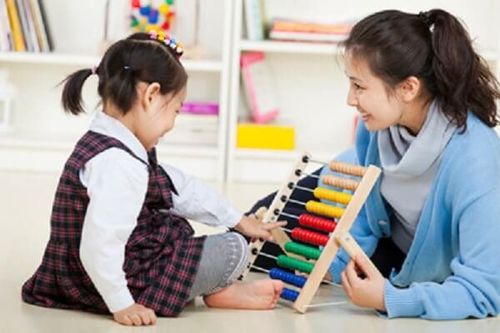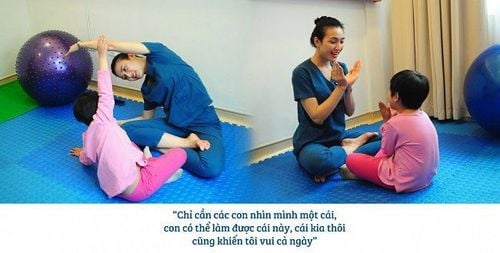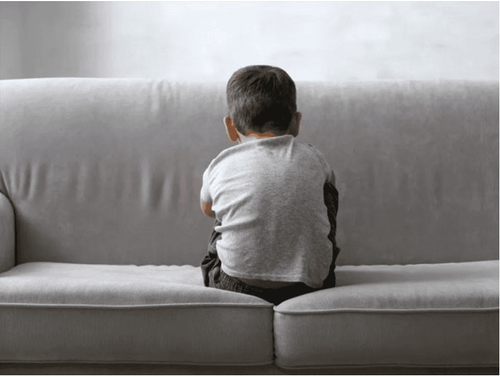This is an automatically translated article.
Autism, also known as autism spectrum disorder, is a form of disease in the group of pervasive developmental disorders and affects many aspects of a child's development. Currently, there is no cure for the disease completely, but early intervention will help children integrate into the environment better.
1. Principles of treating children with autism
Principles in the treatment of children with autism include:
Early intervention for children with autism right after detection. Early intervention team: pediatric rehabilitation physician, psychologist, psychiatrist, speech technician, occupational therapist, special education teacher and parents. The intervention program is set up according to the child's autism level and developmental level. Treatment interventions for children with autism must be really persistent and regular in batches at the rehabilitation center in coordination with the Home Training Program. Interventions include: behavioral intervention, speech therapy, communication coaching, music therapy, personal education, career guidance, psychological support,...
2. Speech therapy and communication training
2.1 Initial level training in Attention Skills skills. Imitation skills. Language acquisition skills. Expressive language skills. Skills before going to school. Self-care skills. 2.2 Moderate Skills Training Program Intermediate Skills Training Program is the same as the initial level but at a higher level.
2.3 High Level Skills Training Program The skills are the same as the initial level but at a higher level. Practice some other skills such as: abstract language, social skills, school skills. 2.4 Principles Intervention for children with autism early after communication and language discovery. An early intervention program for language and communication should be based on an assessment of the child's functioning.

Trẻ tự kỷ được can thiệp sớm sẽ dễ hòa nhập với môi trường tốt hơn
2.5 Training on early communication Training on concentration skills for children with autism
Stimulating children to see: Let children sit close to talk, show smiling, sad, happy,... and let children observe . Give toys of different colors and shapes to children to follow. Play peek-a-boo with your child, then wait for them to follow your face. Roll the ball towards the child for the child to follow and ask the child to reach out and catch the ball. Hide familiar toys and objects such as bowls, spoons, cups, etc. in a basket and ask the child to find them. Stimulating children to listen: Shake toys that make sounds such as dice, chits, ... or imitate the sounds of animals for children to hear. Play games that make noises such as imitating animal calls for children to listen to and wait for children to sound along. Talk, play music, or sing children to them, then observe their facial expressions when they hear different sounds. Turn game: put a pebble in a coke can, make a noise for the child to hear and wait for the child to imitate. Let children play in groups: call each child by name and raise their hand when called. Imitation and Turn Training
Imitation: Children learn things through imitation of facial expressions, body movements (raising hands, goodbye...), imitating sounds and words (speaking), imitating imitation of actions (playing with toys),... Turn: Taking turns is one of the important skills that children need to learn when communicating. Pamper your baby with all kinds of sounds, tickle her belly and wait for her to laugh, then pet and tickle her until she responds. Children make sounds and we imitate their sounds and wait for them to respond. Model an action: clap, raise your hand and tell your child to do it, then wait for the child to do it. Play oooh: put your hand over your face and say “uh”, then remove your hand and say “ouch” and wait for the child to laugh. Roll the ball towards the child and say "mine", wait for the child to catch the ball, let the child roll the ball towards you and say "mine". Clap to praise the child. Pretend play: mom cooks rice, baby bathes baby and waits for baby to respond to taking her turn. Play skills training
Through play children learn a lot about:
Early communication skills Language skills. Gross motor skills: crawling, crawling, standing, walking,... Fine motor skills: holding and grasping objects, with objects,... Daily living skills: washing hands, dressing. .. Feeling: seeing, hearing, touching. Explore the world around. Problem solving. Communication training with pictures and gestures
Gestures are one of the very important parts of the communication process. Every day we often use gestures to communicate with others.
Gesture communication includes: Eye contact: looking at the object that the child wants to get. Body movements such as raising your hand or bowing your head to ask for what the child wants. Pointing and reaching: Pointing at something the child wants, waving when saying goodbye, raising your hand to ask for a hug. Visual communication includes: Books, children's stories. Picture cards teach preschoolers: recognize objects and animals in pictures, find picture cards with animals they know in different picture cards. Pair comparison: compare pictures with pictures, objects with pictures, real people with pictures,... Conversation through pictures. Language skills training (speech therapy)
Language comprehension training Language skills training Expression through signs, pictures and symbols. Verbal expression. School skills training Pre-school skills training School skills training. Principles of language teaching Children must understand words and know the meaning of sounds, words and sentences before they can speak. Talk a lot with your child, use simple language, and speak slowly and loudly. Use signs to help your child understand. Only a few objects or pictures and a guide should be used. Encourage and reward children at the right time.

Dựa vào đánh giá chức năng của trẻ tự kỷ để đưa ra chương trình về giao tiếp sớm phù hợp
3. Behavioral Interventions
Analyze the child's adaptive behavior: Analyze the child's inappropriate and abnormal behavior (find the cause of the behavior, the frequency of the behavior, the consequences of the behavior) to eliminate the behavior. abnormal behavior, if possible, replace it with new, more appropriate behavior, reducing the impact of the cause. Behavioral intervention program for children with autism: includes 100 exercises arranged from simple to more complex. Each exercise can have many more small acts. Set up a behavioral intervention program: choose about 1-10 lessons, each lesson choose from 1-3 items and arrange them on a behavioral intervention card. Evaluation: initial assessment of children's levels of exercise performance and after a few months of intervention. Use a rating scale as follows: 0: child does not do it on their own 1: child does with action support 2: child does with verbal support 3: child does it without support 4: child does it right Intervention time for children with autism is at least 60 minutes/day and is done daily, preferably 40 hours/week for 1-3 years after detecting the child has autism. Human resources: Rehabilitation doctors, technicians, preschool teachers and families.
4. Sensory conditioning
Sensory conditioning is one of the treatments for autistic children with sensory disturbances such as touch, hearing, sight, taste, touch and balance. In addition, sensory conditioning is used to increase or decrease the child's response to different stimuli.
5. Music therapy for children with autism
Acoustic integration training for children with increased sensitivity to sounds or hypersensitivity to sounds. While teaching children with autism can coordinate children's songs and teacher gestures related to the task we are teaching. This will stimulate children to increase concentration, more interested in learning.

Âm nhạc trị liệu cho trẻ tự kỷ giúp tăng tương tác và cảm xúc giữa các cá nhân
6. Vision training
Children with autism have limited eye contact, so eye contact exercises need to be done continuously in the process of teaching children. It is possible for children to wear glasses with special colors, special techniques to limit abnormal vision such as squinting, to help children focus on what we are teaching.
7. Have fun
Play in groups in small groups: children with autism often limit their main group play skills, so it is advisable for children to play in a group of about 10 friends on a certain topic such as family, doctors, cooking. baking, building,...) under the guidance of teachers to help children integrate with friends. Larger group play: to help children with autism understand the rules of games and social interactions, and develop better interpersonal and social skills. In the lessons of children with autism should use familiar children's toys to help children understand the lesson better.
8. Personal education
Individual education plays a very important role in improving the behavior of children with autism and enhancing their concentration and learning ability.
9. Drug treatment
Some drugs are used in the treatment of autism, helping to reduce symptoms of seizures, hyperactivity, aggression, poor concentration.

Có thể sử dụng thêm một số loại thuốc để hỗ trợ quá trình điều trị tự kỷ cho trẻ
10. Autistic child education and family counseling
The school and the child's parents need to encourage the child to go to school. Parents can contact rehabilitation doctors, rehabilitation technicians at the Rehabilitation Departments of hospitals or orthopedic and rehabilitation centers to get information about rehabilitation for children with autism.
11. Vocational training
With early career guidance, children with autism when they grow up can do simple jobs: housework, planting trees, raising cattle, simple crafts,...
12. Psychological support
Children and adults with autism do not receive early rehabilitation, but may have psychological problems that need support from psychologists. Families need to explain to autistic children about their illness, accept and overcome their guilt. The school needs to explain to the students in the school about the illness of the autistic child in order to have sympathy and help. In summary, autism, also known as autism spectrum disorder, is a disease in the group of pervasive developmental disorders and affects many aspects of a child's development. Treatment for children with autism, parents must be really patient so that their children get the best results. Parents need to apply therapeutic methods for autistic children at any time so that the child can better integrate with the surrounding environment.
Clinic and educational psychology unit of Vinmec Times City Hospital's Regenerative Medicine Center is a pioneer in applying scientific and artistic methods to assess and treat children with autism, bringing effective results. high.
Areas of educational intervention for children with autism at Vinmec: Clinical psychology - educational psychology; Special Education; Speech therapy; Meditation – therapeutic yoga; Music therapy; Art therapy
The team of doctors, therapists and teachers at the Center are trained at prestigious schools: University of Education, University of Social and Human Sciences - Hanoi National University, Academy of Sciences education management... and regularly learn to improve skills through short-term and long-term training courses at home and abroad with leading experts from the US, Australia, India, Italy.
Please dial HOTLINE for more information or register for an appointment HERE. Download MyVinmec app to make appointments faster and to manage your bookings easily.













